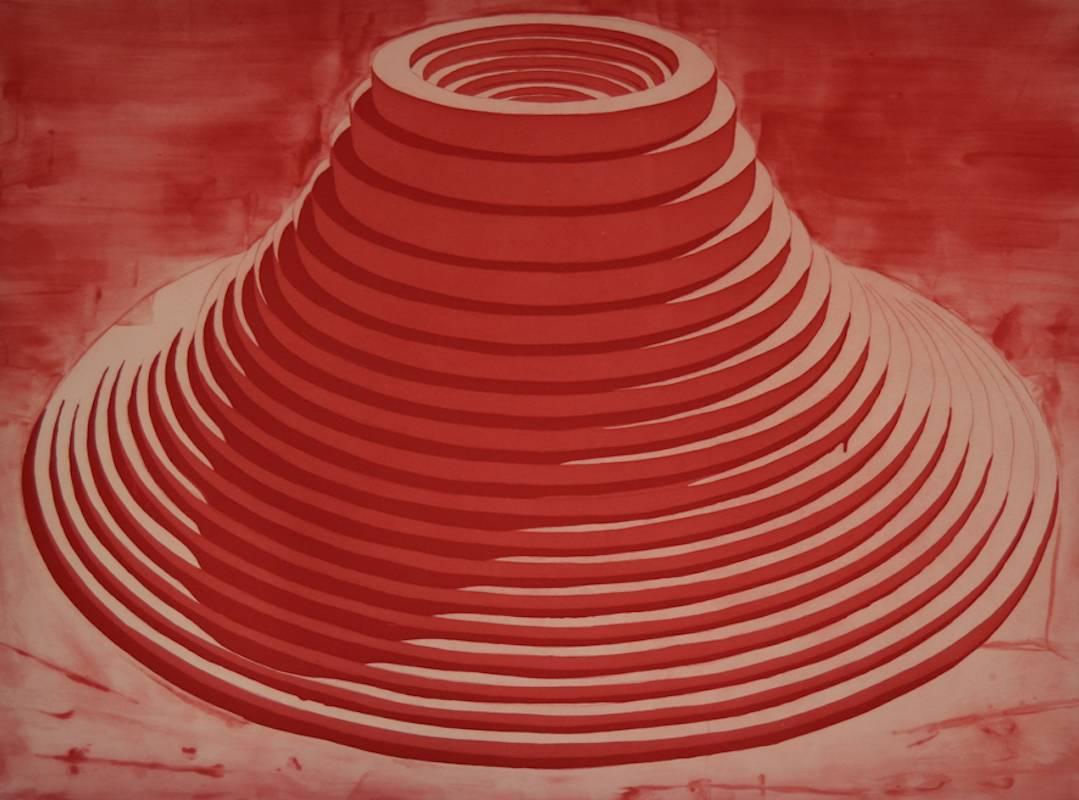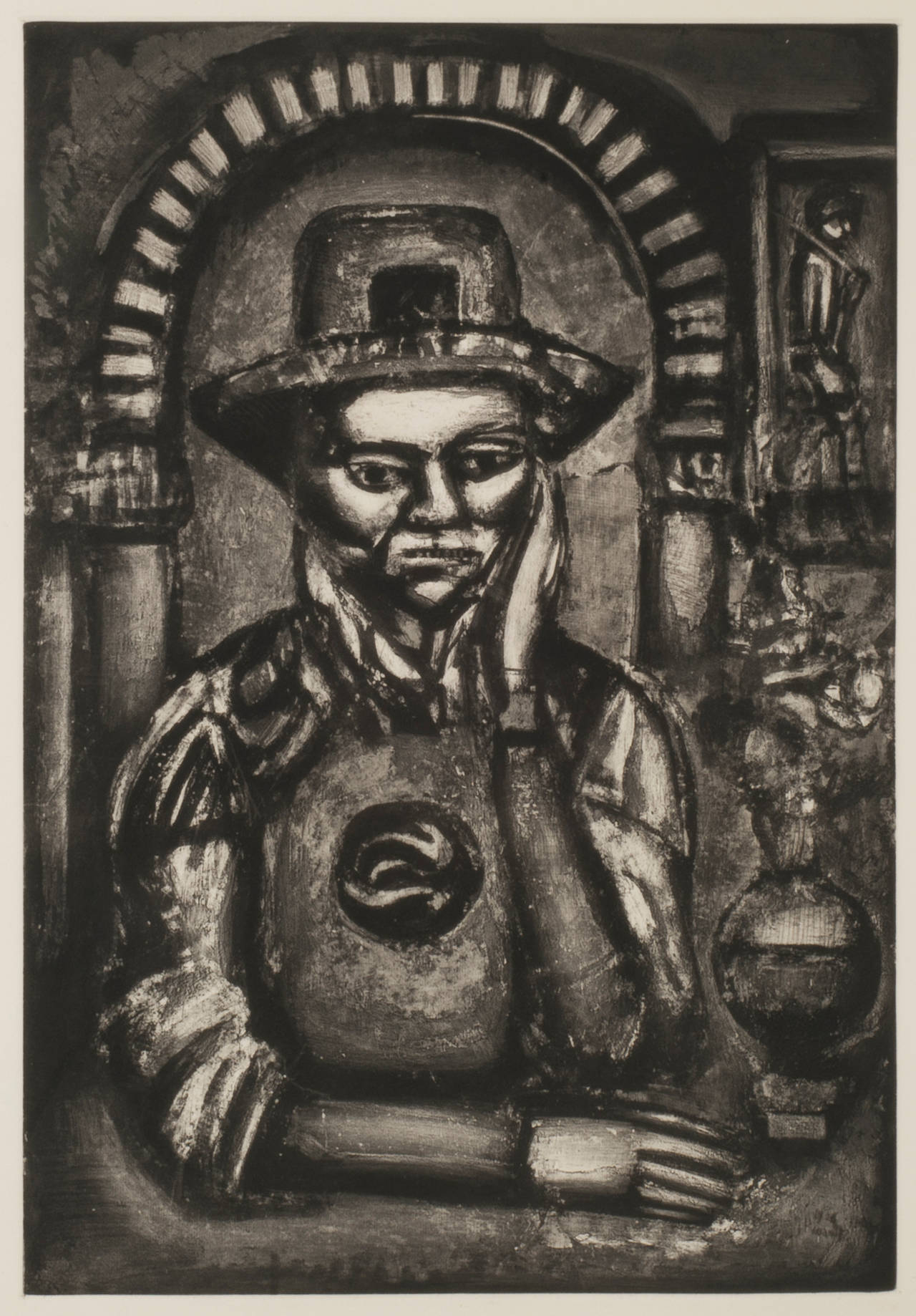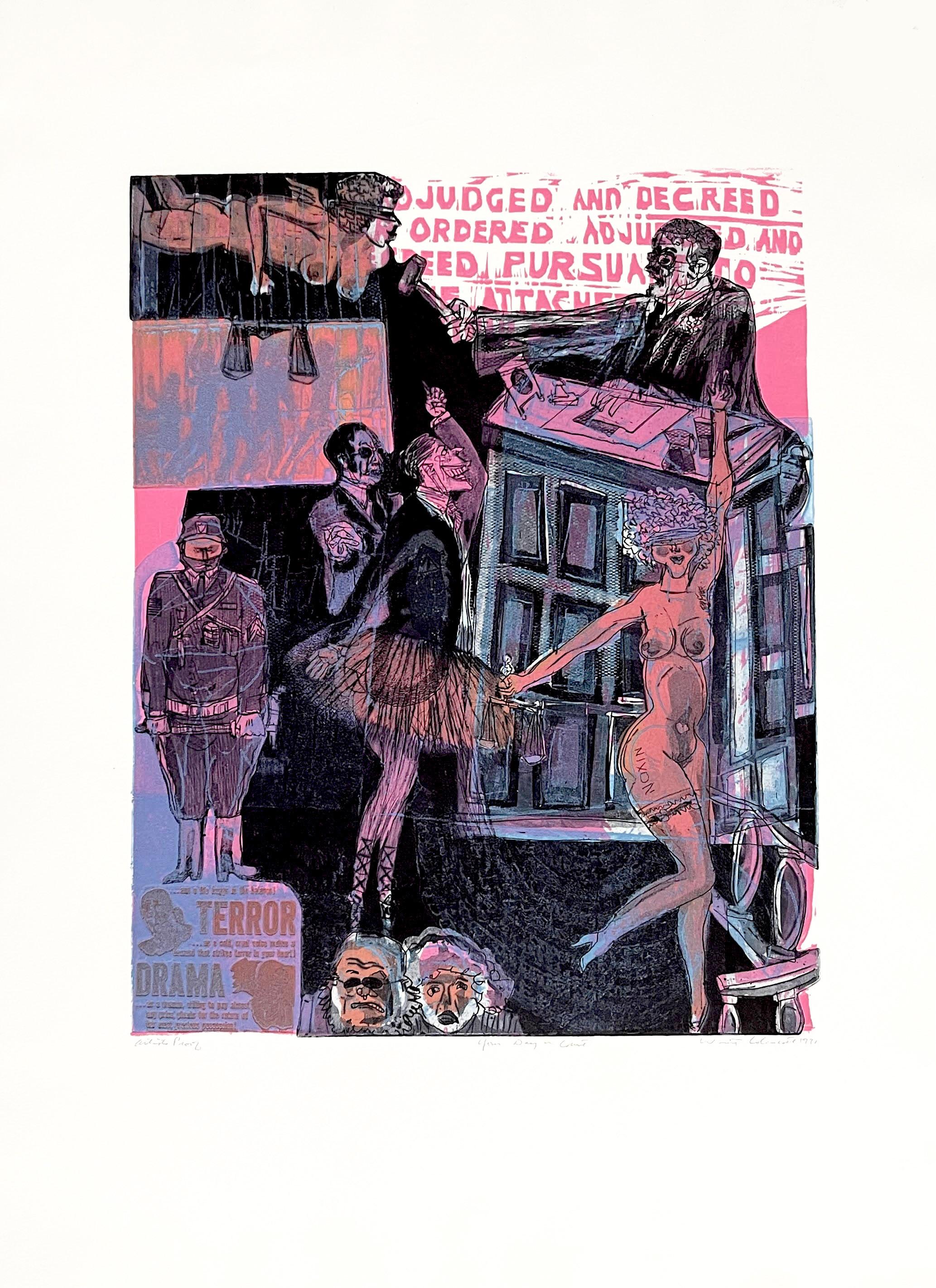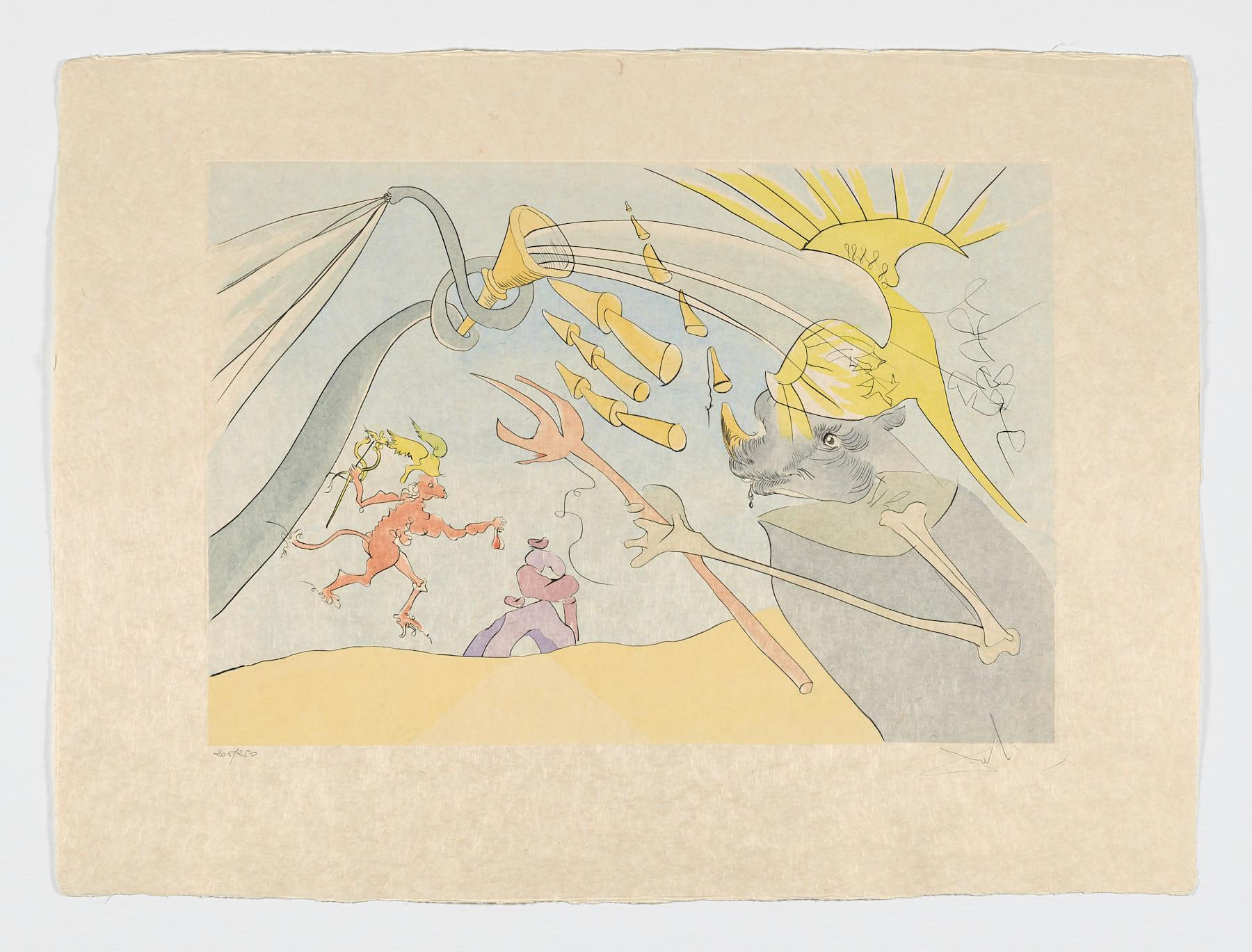Louise BourgeoisLa Réparation2003
2003
About the Item
- Creator:Louise Bourgeois (1911-2010, American, French)
- Creation Year:2003
- Dimensions:Height: 17 in (43.18 cm)Width: 15 in (38.1 cm)
- Medium:
- Period:
- Condition:
- Gallery Location:New York, NY
- Reference Number:1stDibs: LU29328117702
Louise Bourgeois
Louise Joséphine Bourgeois was a French-American artist. Although she is best known for her large-scale sculpture and installation art, Bourgeois was also a prolific painter and printmaker. She explored a variety of themes throughout her long career, including domesticity and the family, sexuality and the body, as well as death and the unconscious. These themes connect to events from her childhood, which she considered to be a therapeutic process. Although Bourgeois exhibited with the Abstract Expressionists and her work has much in common with Surrealism and Feminist art, she was not formally affiliated with a particular artistic movement.
- ShippingRetrieving quote...Ships From: New York, NY
- Return PolicyThis item cannot be returned.
- Vincent with Open MouthBy Alex KatzLocated in New York, NYAquatint and drypoint 14 3/4 x 22 1/4 inches Edition: 58 Artist Proofs: 8 White German Etching paper Printed by Jennifer Melby, New York Co-published by Brooke Alexander, Inc., New Y...Category
1970s Pop Art Prints and Multiples
MaterialsDrypoint, Aquatint
- Night RiverBy Wayne ThiebaudLocated in New York, NYWayne THIEBAUD Night River, 1998/2011 Hard ground etching with drypoint and aquatint printed in blue and black, ed. 9 of 40 15 x 20 in. (unframed)Category
21st Century and Contemporary Pop Art Abstract Prints
MaterialsEtching, Aquatint, Drypoint
- SunnyBy Alex KatzLocated in New York, NYAlex Katz Sunny, 1974 aquatint and drypoint, edition of 52 15 x 22 3/8 in. (38.1 x 56.8 cm)Category
1970s Contemporary Animal Prints
MaterialsAquatint, Drypoint
- Still LifeBy Alex KatzLocated in New York, NYAlex Katz Still Life, 1974 aquatint and drypoint, edition of 62 22 1/8 x 30 3/4 in. (56.2 x 78.1 cm)Category
1970s Contemporary Still-life Prints
MaterialsAquatint, Drypoint
- New York Sweet: Graveyard RuckusBy Red GroomsLocated in New York, NYRed Grooms New York Sweet: Graveyard Ruckus, 1995 drypoint, etching, sugarlift, and aquatint on Somerset textured paper, ed. of 30 17 1/2 x 20 1/2 in. (44.5 x 52.1 cm)Category
1990s Contemporary Prints and Multiples
MaterialsEtching, Drypoint, Aquatint
- Together (portfolio)By Louise BourgeoisLocated in New York, NYPortfolio of 6 drypoints and engravings, edition of 15 sheet (ea. approx.): 17 1/8 x 14 15/16" (43.5 x 38 cm) portfolio: 17 11/16 × 15 5/8 × 11/16" (45 × 39.7 × 1.8 cm)Category
Early 2000s Contemporary Prints and Multiples
MaterialsEtching, Drypoint
- Vulcano 1By Alexandre ArrecheaLocated in Mexico City, MXAlexandre Arrechea´s work remains caught in an endless uphill climb towards a new representational framework. The pieces he produces serve as a warning of our own limits and how pret...Category
2010s Abstract Abstract Prints
MaterialsDrypoint, Aquatint
- Mapa frente al espejo (Africa) / Map in front of the Mirror (Africa)By Alexandre ArrecheaLocated in Mexico City, MXAlexandre Arrechea´s work remains caught in an endless uphill climb towards a new representational framework. The pieces he produces serve as a warning of our own limits and how pret...Category
2010s Abstract Abstract Prints
MaterialsDrypoint, Aquatint
- Chinois inventa, dit-on, la poudre a canon, nous en fit donBy Georges RouaultLocated in Fairlawn, OHChinois inventa, dit-on, la poudre a canon, nous en fit don (The Chinese invented gunpowder, they say, and made is a gift of it) Aquatint, roulette, drypoint, acid bite, and scorper, 1926 From: Miserere, Plate 38 Initially started by Ambrose Vollard, this portfolio was published in 1948 by Editions de l'Etoile Filante, Paris This image is the cover illustration for the 1938 MOMA catalog...Category
1920s French School Portrait Prints
MaterialsDrypoint, Aquatint
- Your Day in Court, from the portfolio Wisconsin GraphicsBy Warrington ColescottLocated in New York, NYWarrington Colescott Your Day in Court, from the portfolio Wisconsin Graphics, 1971 Drypoint, etching, aquatint, woodcut, & soft-ground etching, w roulette, vibrograver, letterpress ...Category
1970s Modern Figurative Prints
MaterialsDrypoint, Etching, Aquatint, Woodcut
- Spanish Artist hand signed limited edition original art print drypoint n7By Salvador DalíLocated in Miami, FLSalvador Dali (Spain, 1904-1989) 'La Cour du Lion', 1974 Serie: Le Bestiaire de La Fontaine dry point, aquatint on japanese paper 30.6 x 22.7 in. (77.5 x 57.5 cm.) Edition of 250 Unframed ID: DAL2001-007 Hand-signed by author It appears reviewed in the catalog raisonné: The official catalog of the graphic works of Salvador Dalí. Albert Field. Page: 2/93. Nr. 74-1 J. ______________________________________________________ Salvador Felipe Jacinto Dalí i Domènech was a Spanish painter, sculptor, engraver, set designer and writer of the 20th century. An artist associated with surrealism, he is one of the most important figures in 20th century art, representing the archetype of the spectacular contemporary multifaceted artist. He develops his creative activity in various fields through the most diverse cultural formulas: painting, written media, performing arts, cinema, or public appearances in the press, radio, cinema, advertising, television, etc. Master of the most refined pictorial technique, especially drawing, along with various aesthetic languages - from impressionism, cubism, purism or late ultraism with Dadaist edges to the most radical surrealism, hyperrealism, pop-art or art optical—, will absorb every influence that is useful to build its own and personal language, halfway between technical tradition and thematic avant-garde. His paranoid-critical method is his main contribution to the surrealist movement and to the history of art as a new creative model with which Dalí's theories acquire theoretical entity - thanks to the successive interpretations that the Empordà artist made of his readings of Dalí's work. Sigmund Freud—and practice, applying it as a revealing liquid of images that can be represented plastically through multiple images, anamorphisms, relational mirages, irrational and heterogeneous symbolic images, pseudohallucinations, childhood memories, atavisms, obsessive ideas, etc., and recreating a polyphonic method capable of critically relating any visual or sensitive experience. With his method, Dalí makes paranoid delirium a whole mode of expression of an art that introduces us to the concrete irrationality that inhabits every creative process, constructing not only his works, but also his own character. as an artist. In Dalí, the relationship between his work and his personal history becomes evident. Much of the most significant biographical facts for the artist are implicitly or explicitly present in the content of his work and are the explanation of his complex and contradictory personality. In 1910, at the age of 6, he was enrolled by his father in the Hispano-French school of the Immaculate Conception of Figueres, where he learned French, his future language of culture. Dalí's first contact with Impressionism occurred in 1916, when he spent some time on the outskirts of Figueres, specifically at the Molí de la Torre estate, property of the Pichot family (intellectuals and artists), where he was the collection of the painter Ramón Pichot. In 1919 he participated for the first time in a group exhibition in the halls of the Societat de Concerts, and with a group of friends from the institute founded the magazine Studium, in which he published his first writings. A year later he moved to Madrid to study at the School of Fine Arts. In 1922 he won his first prize at the Concurs-exposició d'obres d'art originals d'students, held at the Galeries Dalmau (Barcelona). This same year he attended the School of Painting, Sculpture and Engraving in Madrid (Royal Academy of Fine Arts of San Fernando), and lived in the Student Residence, where he became friends with prominent personalities such as Luis Buñuel, Federico García Lorca, Pedro Garfias , Eugenio Montes, or Pepín Bello. However, a year later he was expelled from the Academy for his rebellious and revolutionary character, accused of leading a protest. It would be in 1927 when his surrealist period began, after having traveled to the Netherlands and France, meeting Flemish painters and Picasso. In Paris itself, in 1929, through Joan Miró, he came into contact with a group of surrealists headed...Category
1970s Surrealist Prints and Multiples
MaterialsDrypoint, Paper, Aquatint
- Spanish Artist hand signed limited edition original art print drypoint n6By Salvador DalíLocated in Miami, FLSalvador Dali (Spain, 1904-1989) 'L’Elephant et le singe de Jupiter', 1974 Serie: Le Bestiaire de La Fontaine dry point, aquatint on japanese paper 22.9 x 30.8 in. (58 x 78 cm.) Edition of 250 Unframed ID: DAL2001-006 Hand-signed by author It appears reviewed in the catalog raisonné: The official catalog of the graphic works of Salvador Dalí. Albert Field. Page: 2/93. Nr. 74-1 B. ______________________________________________________ Salvador Felipe Jacinto Dalí i Domènech was a Spanish painter, sculptor, engraver, set designer and writer of the 20th century. An artist associated with surrealism, he is one of the most important figures in 20th century art, representing the archetype of the spectacular contemporary multifaceted artist. He develops his creative activity in various fields through the most diverse cultural formulas: painting, written media, performing arts, cinema, or public appearances in the press, radio, cinema, advertising, television, etc. Master of the most refined pictorial technique, especially drawing, along with various aesthetic languages - from impressionism, cubism, purism or late ultraism with Dadaist edges to the most radical surrealism, hyperrealism, pop-art or art optical—, will absorb every influence that is useful to build its own and personal language, halfway between technical tradition and thematic avant-garde. His paranoid-critical method is his main contribution to the surrealist movement and to the history of art as a new creative model with which Dalí's theories acquire theoretical entity - thanks to the successive interpretations that the Empordà artist made of his readings of Dalí's work. Sigmund Freud—and practice, applying it as a revealing liquid of images that can be represented plastically through multiple images, anamorphisms, relational mirages, irrational and heterogeneous symbolic images, pseudohallucinations, childhood memories, atavisms, obsessive ideas, etc., and recreating a polyphonic method capable of critically relating any visual or sensitive experience. With his method, Dalí makes paranoid delirium a whole mode of expression of an art that introduces us to the concrete irrationality that inhabits every creative process, constructing not only his works, but also his own character. as an artist. In Dalí, the relationship between his work and his personal history becomes evident. Much of the most significant biographical facts for the artist are implicitly or explicitly present in the content of his work and are the explanation of his complex and contradictory personality. In 1910, at the age of 6, he was enrolled by his father in the Hispano-French school of the Immaculate Conception of Figueres, where he learned French, his future language of culture. Dalí's first contact with Impressionism occurred in 1916, when he spent some time on the outskirts of Figueres, specifically at the Molí de la Torre estate, property of the Pichot family (intellectuals and artists), where he was the collection of the painter Ramón Pichot. In 1919 he participated for the first time in a group exhibition in the halls of the Societat de Concerts, and with a group of friends from the institute founded the magazine Studium, in which he published his first writings. A year later he moved to Madrid to study at the School of Fine Arts. In 1922 he won his first prize at the Concurs-exposició d'obres d'art originals d'students, held at the Galeries Dalmau (Barcelona). This same year he attended the School of Painting, Sculpture and Engraving in Madrid (Royal Academy of Fine Arts of San Fernando), and lived in the Student Residence, where he became friends with prominent personalities such as Luis Buñuel, Federico García Lorca, Pedro Garfias , Eugenio Montes, or Pepín Bello. However, a year later he was expelled from the Academy for his rebellious and revolutionary character, accused of leading a protest. It would be in 1927 when his surrealist period began, after having traveled to the Netherlands and France, meeting Flemish painters and Picasso. In Paris itself, in 1929, through Joan Miró, he came into contact with a group of surrealists headed...Category
1970s Surrealist Prints and Multiples
MaterialsDrypoint, Aquatint, Paper






